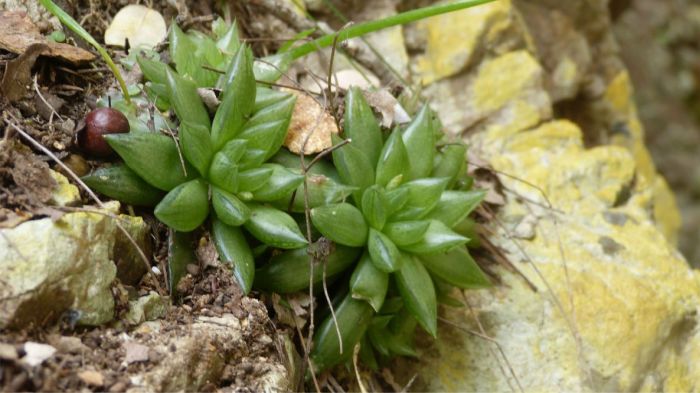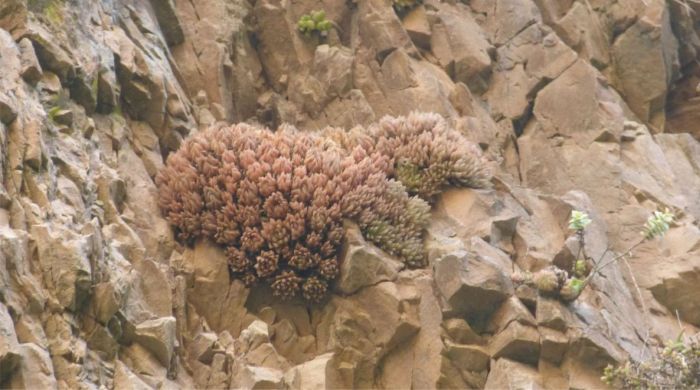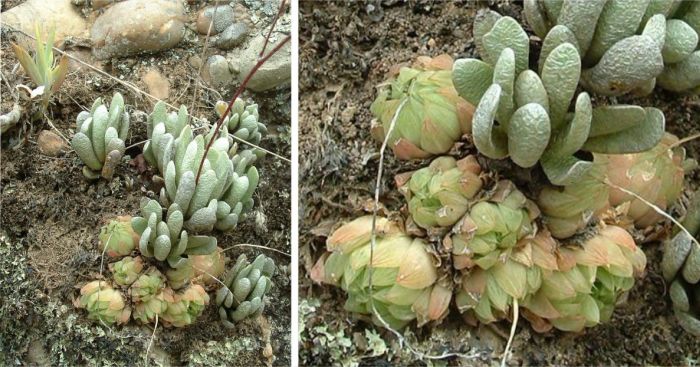Haworthia cooperi var. picturata
Haworthia cooperi Baker var. picturata (M.B.Bayer) M.B.Bayer (= Haworthia gracilis Poelln. var. picturata M.B. Bayer)
Family: Asphodelaceae
Common names: Grootrivier cliff-haworthia (Eng.), Grootrivier dwergaalwyntjie (Afr.)
Introduction
Haworthia cooperi var. picturata is a decorative, dwarf, compact, cliff-hugger, consisting of numerous, small, bright green rosettes of green partially translucent, succulent leaves. They grow on cliffs along the Grootrivier and surroundings, Eastern Cape. It flowers in spring and early summer when the solitary inflorescence, bearing white flowers, appears. Best grown in containers.

Fig. 1. The Grootrivier cliff haworthia (Haworthia cooperi var. picturata) growing on a sheer cliff at Geelhoutboskloof; note the young inflorescence emerging.
Description
Description
Plants dwarf-sized, neatly rosulate, prolific from base, forming small rounded clusters up to 80 mm in diameter and consisting of up to 12 heads. Rosettes about 35 mm in diameter. Roots grey, terete, up to 4 mm in diameter. Leaves up to 25, soft, oblanceolate, ascending-spreading; apices translucent, striate, obtuse or acute, mucronate; upper side flat to channelled or slightly convex, lower surface cymbiform; surface smooth, green, becoming pinkish green during dry periods; margin entire. Inflorescence racemose, 150–350 mm long, 8–12-flowered in distal half; bracts white, clasping, up to 3 mm long, ovate-acuminate; pedicels 2 mm long. Perianth tubular, curved, ascending-spreading, 15 mm long, white purplish with green mid-stripe. Fruit 8 × 2.5 mm. Seed oblong, 2 × 1 mm, grey brown. Flowering is mainly from spring to early summer (October–November). Seeds are dispersed by wind in summer and early autumn.

Fig. 2. Two plants of the Grootrivier cliff haworthia (Haworthia cooperi var. picturata) on a cliff along the Kouga River (Farm Hoerree).
Conservation Status
Status
Haworthia cooperi var. picturata is widespread within the Cape Fold Mountains in the Eastern Cape and especially the Baviaanskloof and Kouga Rivers. The plants are safeguarded by their difficult-to-reach habitat, and its distribution falls within a greater conservation region. Consequently, it is not threatened.

Fig. 3. Geelhoutboskloof in the Baviaanskloof, habitat of many cliff-dwelling succulents, such as Haworthia cooperi var. picturata (LEFT). A cluster of the cliff-hugging Haworthia cooperi var. picturata in flower at Geelhoutboskloof, growing with Haworthiopsis viscosa, Crassula lactea and Crassula rupestris. (RIGHT).
Distribution and habitat
Distribution description
Haworthia cooperi var. picturata is widespread in the Grootrivier System which includes the Kouga River, Baviaanskloof River and Grootrivier (meaning ‘great river’), a region within the Cape Fold Mountains, with a very diverse terrain at an altitude of between 400–1 000 m. The habitat consists of mainly south-facing, quartzitic sandstone cliffs (light-coloured and smooth-textured), of the Peninsula Formation (Cape Supergroup). The substrate has many ledges, crevices and fissures and is ideal for establishment of plants.
Plants are firmly rooted in crevices. Temperatures in summer are high (35–40°C). Winters are cooler but frost is absent. The average daily maximum temperature is about 27°C and the average daily minimum is about 12°C. Rainfall occurs throughout the year but with a peak in spring and summer, ranging from 300–400 mm per annum, in the form of thunder showers or cyclonic winter rain. Plants also grow at Enon, near Kirkwood, on Enon Conglomerate cliffs.
The associated vegetation includes Gamtoos Thicket of the Albany Thicket Biome (Mucina et al. 2006). The associated cliff-dwellers along the Baviaanskloof River includes Albuca batteniana, Bulbine cremnophila, Cotyledon tomentosa, Crassula perfoliata var. minor, Crassula perforata, Cyrtanthus labiatus, Cyrtanthus montanus and Gasteria rawlinsonii.

Fig. 4. A solitary plant of the Grootrivier cliff haworthia (Haworthia cooperi var. picturata) along the Grootrivier, Eastern Cape, growing with Crassula cordata and Crassula pellucida subsp. marginalis.
Derivation of name and historical aspects
History
Haworthia cooperi is named after Thomas Cooper (1815–1913), an English botanist and explorer who came to South Africa in 1859. The varietal name picturata, means ‘variegated’, referring to the contrasting dark (opaque) and light (translucent) areas on the leaves.
Haworthia cooperi was named by J.G. Baker in Refugium Botanicum in 1871. The variety picturata was created by Bruce Bayer in 1999, in his book Haworthia Revisited, from plants growing at Enon, near Kirkwood, accommodating a decorative group of cliff-dwelling plants with conspicuously windowed green leaves. This variety was previously treated as a variety of Haworthia gracilis, a genus named by Karl von Poellnitz in 1929 in the journal Feddes Repertorium.
Haworthia is a difficult genus, in terms of defining and naming, and contains many populations of uncertain identity, with many characteristics by which they can be defined, and also much variation, and consequently they can be difficult to pin down. Bayer (2011) makes sense of this variability by also considering their geographic distribution and whether or not they co-occur. The result of his field study and analysis was many name changes, detailed in Bayer and Manning (2012). The one that concerns us here is that the species Haworthia gracilis is now reclassified as a variety of H. cooperi, and all varieties of H. gracilis are now reclassified as varieties of H. cooperi.
Haworthia cooperi var. picturata is one of 13 recognised varieties within this variable species (Bayer & Manning 2012). These are var. cooperii, var. dielsiana, var. doldii, var. gordoniana, var. gracilis, var. isabellae, var. leightonii, var. pilifera, var. tenera, var. truncata, var. venusta, var. viridis and var. picturata. This genetic variability, or plasticity, reflects its ability to adapt to local conditions and colonise new habitats. Most varieties are not confined to cliffs, however, H. cooperi var. picturata is only known from cliffs and is at once distinguished by its entire leaves with large windows at the tips, the translucent areas contrast strongly with the dark green, opaque leaf surface.

Fig. 5. The Grootrivier cliff haworthia (Haworthia cooperi var. picturata) in cultivation. A fully turgid leaf rosette, showing the conspicuous, large, translucent windows.
Ecology
Ecology
The plants grow in small to large, rounded clusters, on shady cliffs, suggesting an adaptation to maximise light absorption in its shady environment. The leaves are flattened, compact and distinctly incurved, an adaptation to the semi-arid environment and also regulating excessive absorption of light, but they can become very turgid. During the moist season the leaves are green, but turn purplish during dry periods, as the plants aestivate, blocking out excessive light and reducing photosynthesis. The windows on the leaf surface allow the penetration of light into the inner tissue, allowing effective photosynthesis and energy in this shady, cool cliff environment.

Fig. 6. A large cluster of the Grootrivier cliff haworthia (Haworthia gracilis var. picturata) at Grootrivierspoort during the dry season.
This is a long-lived, succulent, with a soft texture, withering from the base. After rain, the leaves become turgid, but are channelled during dry periods, an adaptation to the extreme dry habitat. The soft leaf texture and entire margin (occasionally ciliate) suggest a reduction in armament in response to the undisturbed cliff habitat in contrast to the thorny but heavily grazed surrounding thicket vegetation.
The inflorescence grows ascending to spreading, the white flowers attracting a flying insect that pollinates them.
The seed is small and angular, ideal for establishment in crevices. The seed is shaken from the capsules and dispersed by wind. The capsules ripen in summer and autumn, coinciding with the rainy season. Germination usually occurs within 14–21 days.
Haworthia cooperi var. picturata suckers freely from the base, forming dense clusters. Continual sprouting from the base represents an efficient vegetative backup dispersal strategy for this harsh cliff-face environment. Heads blown from the cliff will root where they land.

Fig. 7. The Grootrivier cliff haworthia (Haworthia cooperi var. picturata) growing on a sheer cliff at Baviaanskloof sharing its habitat with Cotyledon tomentosa subsp. tomentosa and Adromischus sphenophyllus.
Uses
Use
No medicinal or cultural uses have been recorded.

Fig.8. A cluster of the the Grootrivier cliff haworthia (Haworthia cooperi var. picturata) growing at Enon, on Enon Conglomerate cliffs, Here sharing its habitat with Caputia scaposa and Curio ficoides.
Growing Haworthia cooperi var. picturata
Grow
Haworthia cooperi var. picturata is easily cultivated, but outside of its habitat it requires protection from frost, excessive sunlight and moisture, thus it is best in a greenhouse, where conditions can be controlled. The soil should be sandy and well-drained and slightly acidic, and the aspect shady, as is found in its natural habitat. The young plants start solitary, soon dividing to form small, dense clusters. It is suitable for small containers and miniature gardens. in partial shade. It is also suitable for window sills. Water can be given throughout the year, but sparingly in winter. Feed in spring and summer with a diluted organic fertiliser or well broken-down compost. It is popular in cultivation and grown worldwide.
It is easily propagated by division. Plants can be divided any time of the year, but better in spring. Plant in a shallow tray in a sandy mixture (e.g. peat, sand and polystyrene) and kept moist. Rooting is within 3 weeks and once well-rooted, transfer to individual containers. Place containers in a shady position but with full light, the south side of a building is ideal.
Sow seed in spring, summer or autumn in a sandy medium. First moisten the substrate with fine rose. Cover the seed lightly with a thin layer of sand. Keep moist and in a shady position. Germination is usually within 3 weeks and the young seedlings are relatively fast growing. Transplant seedlings to individual containers once large enough to handle.
Plants are relatively disease free but aphids, slugs and snails can sometimes be a problem.
References
- Bayer, M.B. & Manning, J.C. 2012. A rationalization of names in Haworthia. A list of species with new combinations and new synonyms. Alsterworthia International 12: 7–16.
- Bayer, M.B. 1999. Haworthia revisited, a revision of the genus. Umdaus Press, Hatfield.
- Bayer, M.B. 2011. Haworthia Updates. Volume 1, Chapter 1: Haworthia gracilis, H. cymbiformis and H. cooperi in the greater Baviaanskloof area. Online. https://haworthiaupdates.org/site-map-2/
- Charters, M.L. 2006–2016. The Eponym Dictionary of South African plants. Published online at http://www.calflora.net/southafrica/1Titlepage.html
- Haworth, A.H. 1812. Synopsis Plantarum Succulentarum. London.
- Mucina, L. & Rutherford, M.C. (eds) 2006. The vegetation of South Africa, Lesotho and Swaziland. Strelitzia 19. South African National Biodiversity Institute, Pretoria.
- Raimondo, D., Von Staden, L., Foden, W., Victor, J.E., Helme, N.A., Turner, R.C., Kamundi, D.A. & Manyama, P.A. (eds) 2009. Red list of South African plants. Strelitzia 25. South African National Biodiversity Institute, Pretoria.
- Scott, C.L. 1985. The genus Haworthia, a taxonomic revision. Aloe Books, Johannesburg.
- Von Poellnitz, K. 1929. Contributions to the knowledge of the genera Haworthia Duval and Gasteria Duval. Feddes Repertorium Specierum Novarum Regni Vegetabilis 27: 132.
Credits
Ernst van Jaarsveld
Kirstenbosch National Botanical Garden (Retired 2015)
Babylonstoren Farm
Extraordinary senior lecturer and researcher,
Department of Biodiversity and Conservation, University of the Western Cape
and Alice Notten
Kirstenbosch National Botanical Garden
February 2022
Plant Attributes:
Plant Type: Succulent
SA Distribution: Eastern Cape
Soil type: Sandy
Flowering season: Spring, Early Summer
PH: Acid
Flower colour: White
Aspect: Shade, Morning Sun (Semi Shade), Afternoon Sun (Semi Shade)
Gardening skill: Easy
Special Features:
Horticultural zones








Rate this article
Article well written and informative
Rate this plant
Is this an interesting plant?
Login to add your Comment
Back to topNot registered yet? Click here to register.